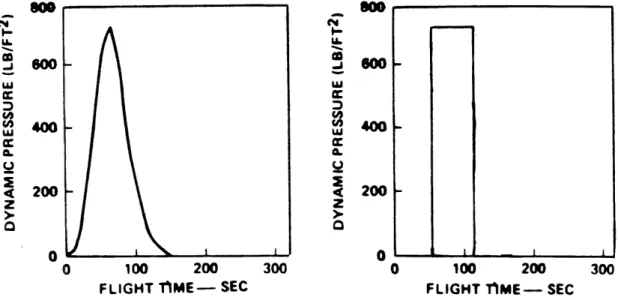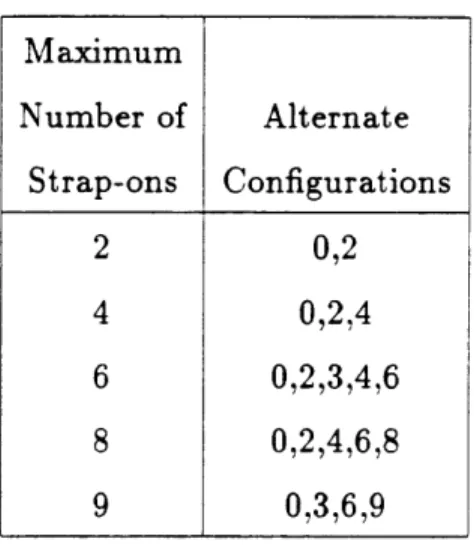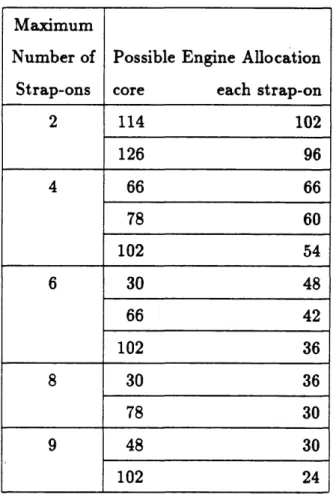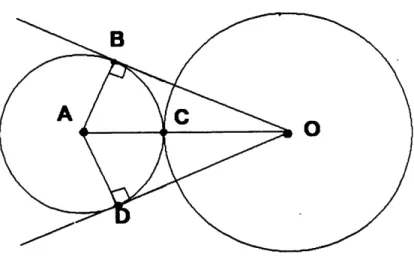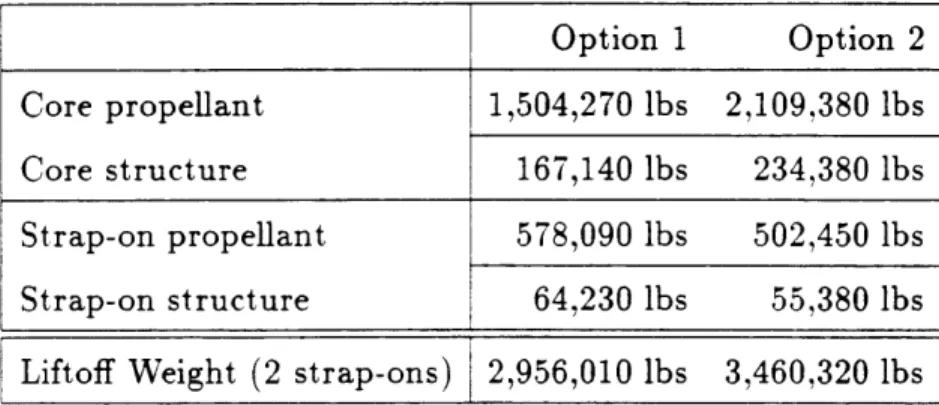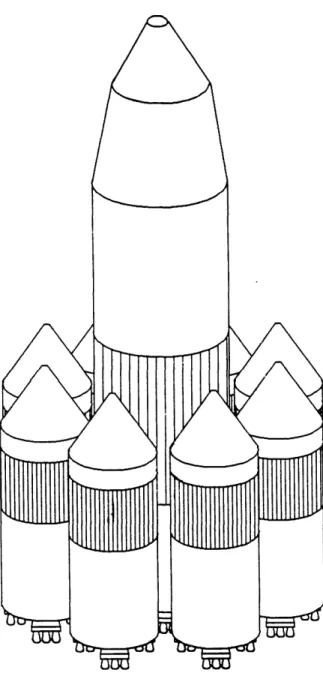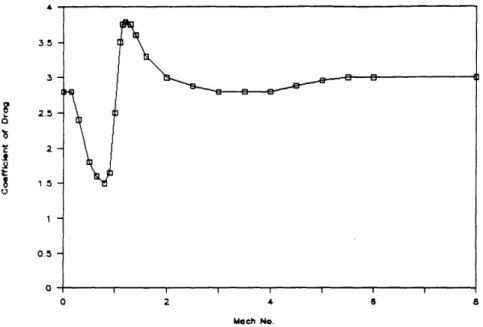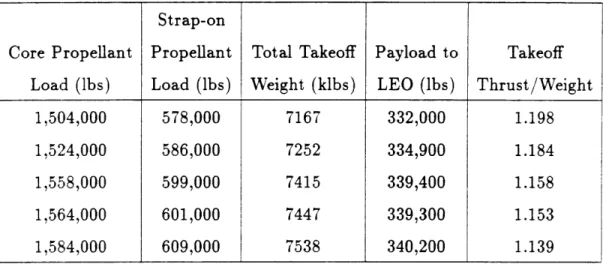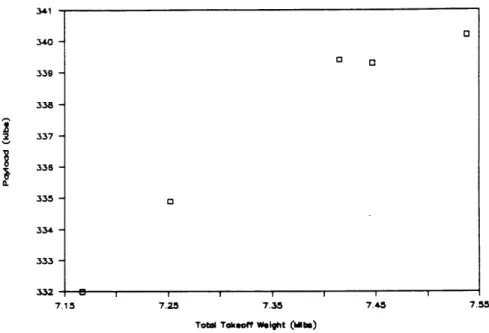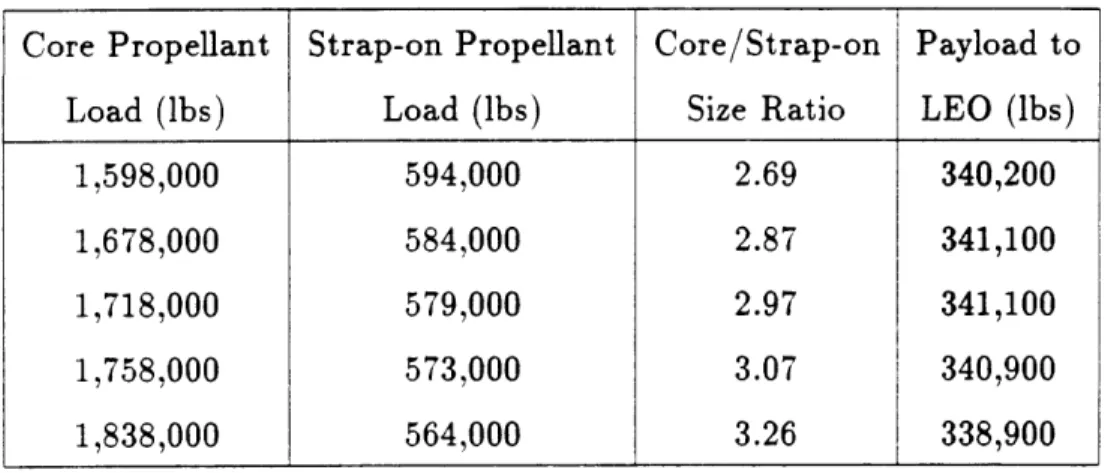Analysis of a Heavy Lift Launch Vehicle Design
Using Small Liquid Rocket Engines
by
DAVID PHILLIP RUSS
S.B., Massachusetts Institute of Technology
1987
SUBMITTED IN PARTIAL FULFILLMENT
OF THE REQUIREMENTS FOR THE
DEGREE OF
MASTER OF SCIENCE IN
AERONAUTICS AND ASTRONAUTICS
at the
MASSACHUSETTS INSTITUTE OF TECHNOLOGY
May 1988
®
David P. Russ 1988The author hereby grants M.I.T. and Hughes Aircraft Company permission to reproduce and to distribute copies of this thesis document in whole or in part. Signature of Author
Department of Aeronautics and Astronautics
December 18, 1987
Reviewed by
C. P. Rubin
Hughes Aircraft Company Certified by
Thesis Supervjsor, Departmer
. . .
Professor Walter M. Hollister of Aeronautics and Astronautics Accepted by
, .A
U
Professor Harold Y. Wachman Chairman, Depart'rmental Graduate Committee Department of Aeronautics and AstronauticsMAY i od ;WITHDRAWfIN
i M.I. 1W.i..: P.
Analysis of a Heavy Lift Launch Vehicle Design
Using Small Liquid Rocket Engines
by
David P. Russ
Submitted to the Department of Aeronautics and Astronautics in partial fulfillment of the requirements for the degree of
Master of Science in Aeronautics and Astronautics
May, 1988
Abstract
The trend in launch vehicle design has been to increase performance by using en-gines of greater and greater complexity, which has a negative effect on cost and reliability. However, a design making use of over 300 small, simple rocket engines can deliver over 340,000 lbs to low Earth orbit. This design, derived by using the rocket equations to size the major components, features a 42 ft. diameter core with 78 engines and eight 26 ft diameter strap-ons with 30 engines apiece. The amount of payload carried by this design is maximized by varying five vehicle parameters and selecting values which maximize payload within constraints. Next, a number of externally determined parameters are varied to study the variation in payload if these parameters have unexpected or non-optimal values. The payload capacity is most sensitive to changes in specific impulse and mass fraction; the variation of payload with acceleration limit and number of strap-ons shows the design to be quite flexible. The problem of in-flight engine failure is analyzed with respect to payload capacity, control authority, and propellant management, and methods of dealing with this problem are discussed. The result is a flexible, reliable, and very capable design.
Thesis Supervisor: Walter M. Hollister
Preface
The idea for using a large number of small, simple liquid rocket engines for a heavy-lift launch vehicle is not original to the author. As near as I can tell, the idea came from Paul Visher, a vice president with Space and Communications Group of Hughes Aircraft. This has formed the basis for a whole new enterprise for Hughes: launch vehicle design. The design presented below is sufficiently different from the Hughes design so that it does not infringe on any proprietary data, but it does share most of the key advantages of the Hughes concept.
The author would like to thank the following people and institutions for their invaluable support.
* MIT, and especially Professor Hollister and John Martucelli, director of the Engineering Internship Program. The EIP placed me here, and I am deeply grateful.
* The staff of the Hughes Co-op Office (especially Mimi Shefrin) and Dr. John Drebinger. They, too, have provided key support.
* Chuck Rubin and Dave Knauer, the leaders of the current Hughes launch vehicle effort. They have trusted me enough to give me an interesting position. * My family-mother, father, and brother-who looked at early drafts and pro-vided moral support. They, and the faith in God that they helped to impart, have kept me going.
El Segundo, CA December, 1987
Contents
1 Introduction 6 2 Concept Definition 2.1 Reference Mission .... 2.2 Propulsive Capacity 2.2.1 Actual AV 2.'2.2 Drag AV .... 2.2.3 Gravity AV . . . 2.3 Rocket Equations .... 2.4 Initial Design ... 2.4.1 Engine Selection 2.4.2 Strap-on Design 2.4.3 Propellant Tanks 8 8 8 9... ...10
... ...12
. . . 13... ..15
... . .15
... . 15
...
.20
3 Performance Analysis3.1 Performance Analysis Background 3.1.1 The Trajectory Simulator .
3.1.2 Vehicle Assumptions . . . . 3.:1.3 Analysis Methodology . . . 3.2 Trade Studies ... 3.2.1 Liftoff Weight. 27 27 27 28 32 32 32
...
...
...
...
...
...
...
...
...
...
...
...
...
...
...
...
3.2.2 Core/Strap-on Size Ratio . . 3.:2.3 Core/Strap-on Engine Ratio . 3.2.4 Acceleration Limit ... 3.2.5 Core Shutdown Time . 3.2.6 Trade Study Summary .... 3.3 Variation Studies ...
3.:3.1 Mass Fraction . . . .
3.:3.2 Drag . . . . 3.:3.3 Number of Strap-ons . . . . .
3.3.4 Specific Impulse ...
3.:3.5 Variation Study Summary . . 3.4 T:rajectory Description ... 4 Engine Failure 4.1 Overview. 4.2 Payload Capability ... 4.3 Control. 4.3.1 Nominal Control ...
4.3.2 Control with Failed Engines . . 4.3.3 Control Summary ...
4.4 Propellant Consumption Management 4.5 Engine Failure Summary...
5 Conclusion
Bibliography
... . 34.. . . . 36 . . . 38 . . . 40 . . . .42 . . . .42 . . . .42 . . . 43 . . . 45 . . ... . . . .... 47 . . . .47 .. 49 57 57 58 60 60 62 64 65 66 68 70...
...
...
...
...
...
...
...
Chapter
1
Introduction
The problems of getting payload from the Earth's surface into space have intrigued many people during the course of the 20th century. The past 30 years have seen advancement in this field that is more rapid than most other technological fields. Launch vehicles are now available that can place tens of thousands of pounds into low Earth orbit (LEO) and thousands of pounds into geosynchronous Earth orbit (GEO). The two major problems with such vehicles continue to be cost and reli-ability. There is no other form of transportation that costs thousands of dollars per pound delivered; modern launch vehicles have costs that are the equivalent of mailing a letter for $2501. And tremendous reliability is required since the payloads themselves may be worth millions or billions of dollars.
One key area of booster design is engine selection. The choice of engines affects the perforn:lance, cost, and reliability of a launch vehicle in a fundamental way. Up until now, the main focus of engine development has been to develop engines that have great performance. The Space Shuttle Main Engines (SSME's) are a prime example of this. They have a specific impulse (Ip) of 455 seconds in a vacuum, among the highest ever achieved by a rocket engine, and are capable of producing 375,000 pounds (1,670,000 N) of thrust apiece at sea level [1, page A-53]. But,
1
they are extremely expensive and can only be flown for a few flights before a major overhaul. Even with this expense, an engine was shut down in flight.
Thus one item that is needed to build a cost heavy lift launch vehicle is a low-cost, reliable engine of good performance. An example of this is the RL10, developed by Pratt and Whitney and currently used on the Centaur upper stage. This engine has a vacuum I1 p of 440 sec. and has had no in-flight failures in 220 flight firings
[12]. The engine is simple, with a complexity similar to that of a helicopter turbine engine. The only drawback is that this engine produces 15,000 lbs (67,000 N) of thrust at sea level; in other words, an average launch vehicle would need around 50 such engines to get off of the ground. Ignoring this drawback for a moment, the demonstrated reliability of 0.9984 and the possibility of mass production force one to consider a design based on this engine.
The purpose of this thesis is to generate a design using an uprated version of this engine., improve the payload capacity by varying many of its parameters, and address one of the major technical problems with this design, engine failure. This design could offer a major improvement in launch cost and performance.
Chapter 2
Concept Definition
2.1 Reference Mission
The design presented here is that of a heavy lift launch vehicle. The reference mission, then, will be to take 300,000 lbs (136,000 kg) to a circular low Earth orbit (LEO) at 100 nautical miles (185 km) altitude based on a due east launch from Kennedy Space Center. The first step is to use the rocket equations to calculate the amount of propellant needed. These equations, in turn, require knowledge of the amount of propulsive AV the launch vehicle must provide.
2.2 Propulsive Capacity
Consider the dynamics of a vehicle in flight at velocity i at an angle 7 to the local horizontal, as in figure 2.1. The vehicle has mass m, produces a thrust T with a certain specific impulse (I,p), and experiences a drag D.
These forces can be expressed in the following equation [3, page 323]:
dm D
du = -gp-- d - g sin ydt (2.1)
m m
T
U
mg
Figure 2.1: The forces on a launch vehicle in flight. T is the thrust as
resolved in the u direction.
There are four terms present. When integrated, they represent the actual change in velocity (AV.), the propulsive change in velocity (AVp), the change in velocity due to drag (AVD), and the change in velocity due to gravity (AVG). The integration of each term is complicated, but the integrated form can be thought of as follows:
iAV + VD + AVG = AVp (2.2)
Use of the rocket equations to size the vehicle will require evaluating each of these terms.
2.2.1 Actual AV
The actual AV is the difference between the inertial velocity of the vehicle at rest on a rotating Earth and the inertial velocity of the vehicle at burnout in orbit. To first order, this can be approximated by calculating the orbital velocity required
(Vob) and subtracting from it the Earth's rotational speed at the latitude of the
launch site (VErth).
Vob, for low Earth orbit, is found as follows [4, page 126]:
where pi is G (mEarth, the gravitational constant times the mass of the Earth, r is the
distance of the body in orbit from the center of the Earth, and a is the semi-major axis of the orbit.
For a circular orbit, r = a, and assuming the body is- at 185 km altitude,
Vo b 398601. 6378 + 185) = 7793 /sec
or 25,570 ft/sec.
VErth at the equator is found as follows:
27rr 2 r 6378
VEarth = - t = 24 60 60
2460
= 464 m/sec (2.4)or 1520 ft/sec. At other latitudes, this is reduced by a cosine factor. The latitude of Kennedy Space Center is 28.50, giving
VEath = 464 cos L = 464 cos(28.5) = 408 m/sec or 1340 ft/sec.
Thus, zAVa is approximately 7385 m/sec or 24,230 ft/sec.
2.2.2
Drag AV
By definition, drag acts along the direction of the relative airspeed of the launch vehicle. Its magnitude is found as follows:
1
D = pv2CDA,rf (2.5)
2
where p is the local atmospheric density, v is the airspeed, CD is the coefficient of drag, and A,r is the reference area. The grouping 1pv2 is sometimes referred to as q, the dynamic pressure.
This force, when divided by the mass and integrated over time gives the drag
loss as follows.
ŽAVD =
1t
(
) dt
(2.6)
fo i"~m t)
---N -J 600 U
2o
( 200z
0 f in 400 al n 200 Az 0a2t
Z )-L 0 100 200 300 0 100 200 300FLIGHT T'ME- SEC FLIGHT tIME- SEC
Figure 2.2: The first graph is dynamic pressure versus time for another
heavy lift launch vehicle. The second shows an approximation to this.
where tb is the burn time.
Needless to say, this integral is too complicated to evaluate, especially when one does not have a design yet. However, one can approximate the effect of drag by caluclating the peak drag acceleration and assuming that this acceleration is a constant for some period of time. Shown in figure 2.2a is a typical curve for the dynamic pressure of a launch vehicle as a function of time [5, page 81]. To first order, the dynamic pressure can be approximated as in the second graph. The maximum value of q is about 730 lbs/ft2 (35,000 N/m2), and this is the equivalent of lasting for 50 seconds. CD is unknown, but in the atmosphere, it is of the order of 1. Assume that the vehicle has an area equal to 10 times that of the shuttle external tank, or 5940 ft2 (552 m2). The mass is also unknown, but, scaling up
from the space shuttle during the period when drag is near its maximum, it will be of the order of 4,400,000 lbs (2,000,000 kg). This gives (in metric units)
35000.1 552 D 2000000 v50 = 500 m/sec or 1600 ft/sec. .I I W- L
2.2.3
Gravity AV
For a short thrust period t, and neglecting drag, one can integrate equation 2.1 to
obtain [3, page 324]:
AVG = g t sin
y
Over the course of a flight of duration tb, this can be approximated as
AVG - g9 t sin (2.7)
where sin 7 is the integrated average value of sin y over the burn.
This sin has some physical meaning. To first order, it is the time averaged value of sin y, where y is as defined in figure 2.1. Launch vehicles launch straight upward (y = 900) initially. When in a circular orbit, = 0°. Assuming that the launch vehicle pitches over as soon as possible so as to minimize g losses, more time is spent at lower values of y. 300 is a reasonable estimate.
tb is approximated as follows:
tb - mrnpo (2.8)
rh
where mp, op is the propellant mass and rh is the mass flow rate. Given that T is the thrust and I is the specific impulse, and using the definition of specific impulse, one obtains
T
TtbI =
=
(2.9)
rhg mporg
To stay in the air, T > mpg, so tb < I,p for any single stage. For a two stage vehicle, each stage having tb = Ip, this gives tb = I,p overall. The overall
I,p
of the liquid hydrogen/liquid oxygen propulsion is around 400 sec., givingAVG = 9.8 - 400 sin 300 = 1960 m/sec
or 6430 ft/sec.
Thus, the approximations above lead to
AVp = 7385 + 500 + 1960 = 9850 m/sec = 32,300 ft/sec (2.10)
2.3 Rocket Equations
The mass of a launch vehicle can be broken up into three categories [3, page 328]: mpay, the mass of the payload,
mp,,p, the mass of the propellant burned, and
mt,,rc, the mass of the structure and everything else (e.g., residual propellant, avionics, etc.).
The sum of these is mo, the total liftoff mass. There are two ratios, defined as
follows:
1 = (2.11)
mpay + mpop + mrtruc mO
mtruc
e = ---- - (2.12)
mrstruc+ mpop
The ratio E is referred to as the mass fraction. In addition, define the exponent k as follows:
k =AV (2.13)
cn
where c is gIp for each stage and n is the number of stages.
For the entire vehicle (assuming stages of equal I,p and ) [3, page 333]
A
nln (1/R)'/"1
c=
e[(1/)l/n" - 1] + 1 This can be solved for as follows:z
(1
-eek
)
(2.14)
AVp is known to be 9850 m/sec from above. is unknown, but is of the order of 0.1 [3, page 329] 1. This formula allows one to calculate the inverse of the mass ratio
"ap (sec.) 400 350 300 Number of stages 1 2 3 00 23.7 19.8 00 42.5 31.8 oc 106.0 61.9
Table 2.1: for several scenarios.
(~) for a range of I and number of stages2. This is shown in table 2.1. Given the desired payload mass, the liftoff mass of the vehicle is found directly. Clearly, the smaller this number, the smaller the overall vehicle. (The I is the overall average I,, from sea level to vacuum. A one-stage vehicle with strap-ons would be considered a two-stage vehicle.)
An I of 300 seconds corresponds to that of a vehicle that makes much use of solid or non-cryogenic motors, which tend to have lower I,,. The vehicle under consideration would have an average I,, of 400 seconds. One can see the motivation of using an all-liquid propulsion system, as the higher I, results in a much lower total liftoff weight. Note further that there is little benefit for having a third stage; the numbers above show only a 15% loss in liftoff weight for a 50% gain in the number of stages. The next question is whether to have two stages that fire in series or have a core with strap-ons. Since the vehicle must have enough thrust to leave the ground, and since the engines providing this thrust are small, it is best to have as many engines as possible firing at liftoff. Thus, a good baseline is a one-stage core vehicle with strap-ons. The analysis above also yields the size. For a mpa of
300,000 lbs, m0 must be 23.7* 300000 or 7,110,000 lbs. Using E as defined above, 2The analysis for AVp assumed two stages, but the result is only weakly dependent on this
this gives a structural mass of 681,000 lbs and a propellant mass of 6,129,000 lbs.
2.4 Initial Design
2.4.1 Engine Selection
Obviously, a major constraint on launch vehicles is that they must get off the ground. In numeric terms, this means that the thrust must be greater than the weight. Let us assume that the thrust to weight ratio is 1.2 at liftoff, giving a takeoff thrust of 8,532,000 lbs at sea level. Regardless of the choice of small thrust engine, one is going to need hundreds of engines firing at liftoff. If the engines have a thrust of
10,000 lbs apiece, one will need 854 engines; even if the thrust is as great as 100,000
lbs, one will still need 86 engines.
The aforementioned RL10 has a vacuum thrust around 16,500 lbs (73,400 N). However, Pratt and Whitney has conducted a study which concluded that this engine can easily be uprated to 27,000 lbs (120,100 N) of sea level thrust while manintaining the simplicity needed for mass production [2]. This engine, referred to as the RL1OJ, will be used as the baseline engine for this design. Liftoff would require at least 316 such engines.
An efficient scheme for mounting these engines is to mount the engines in clus-ters. From the standpoint of controls and plumbing, each cluster can be treated as a single engine. The RL10 has flown in clusters of 6 on early versions of the S-IV stage, so the engines in this design will be mounted in clusters of 6. Thus, the initial
design will rely on 318 RL1OJ engines.
2.4.2 Strap-on Design
There are a number of possibities for strap-on size and engine placement. For each possibility, there are ways of using the same design with fewer than the maximum possible number of strap-ons. For example, if one had an eight strap-on design,
Table 2.2: Possible alternate configurations that use fewer than the
max-imum number of strap-ons while maintaining symmetry.
one could remove an opposing pair of strap-ons and have a symmetric six strap-on configuration. But, in this example, removal of an odd number of strap-ons is not possible because this would result in asymmetric thrust. All of the possible alternate number of strap-ons are shown for each maximum number in table 2.2. The six and eight strap-on designs offer the widest range of alternate configurations.
Another issue for each possible number of strap-ons is how the engines are allocated between the core and the strap-ons. Shown in table 2.3 are possible ways of placing the engines on the core and each strap-on so that there are 318 of them when all strap-ons are attached. One would like to match this engine allocation with the core/strap-on geometry, so that neither the core nor the strap-ons are carrying too many engines.
Geometrically speaking, the six strap-on configuration would consist of a core with six strap-ons that are of equal size to the core. Note that none of the ways of dividing the engines between the core and the strap-ons lead to an equal or near equal distribution of engines as shown in table 2.3. The eight strap-on case would have strap-ons that are smaller than the core, and the second choice of
Maximum Number of Alternate Strap-ons Configurations 2 0,2 4 0,2,4 6 0,2,3,4,6 8 0,2,4,6,8 9 0,3,6,9
Table 2.3: Possible division
of engines between
core and strap-on.Maximum
Number of Possible Engine Allocation Strap-ons core each strap-on
2 114 102 126 96 4 66 66 78 60 102 54 6 30 48 66 42 102 36 8 30 36 78 30 9 48 30 102 24
Figure 2.3: One of eight strap-ons attached to the core.
engine placement matches this. Thus, the eight strap-on configuration offers the advantages of many alternate configurations and straightforward engine placement; this will be the baseline.
Figure 2.3 shows the strap-on-core geometry. Let O be the center of the core, A the center of the strap-on, C the point of tangency, and points B and D the points of tangency of two lines drawn from the center of the core. For eight strap-ons, LBOD is 450, and LBOA and LDOA are each 22.50. Thus,
BA
- = sin 22.50 = 0.3826 AO
Note further that CA = BA, since both are radii of the strap-on. This gives
CA
=CA
0.3826
CA+OC
which, when solved, leads to
CA
= 0.6199 (2.15)
OC
In other words, the strap-on is 0.6199 or the diameter of the core, or 0.3843 of the area. Note how closely this area ratio matches the second engine placement scheme found above, where the ratio of strap-on to core engines is 30/78 or 0.3846. This is desireable, because one must place a very large number of engines at the
Figure 2.4: A possible scheme for mounting the engines. Each strap-on
has 30 engines, and the core has 78. The exact diameter of the core and
strap-ons are determined later.
bottom of each module, and it is better to spread the engines out as close to ideal as possible. Any other configuration would lead to too many core or too many strap-on engines. Thus, this initial design will have 30 engines on each strap-on and 78 engines on the core. This leads to the engine placement as shown in figure 2.4.
Given the cross-section geometry, the next issue is height. The two most appar-ent ways to scale the booster are as follows:
Option 1 The boosters have the same height as the core. Their volume, and thus
their mass, scale as the area, so each strap-on has a volume that is 0.$843 of the core volume.
Option 2 The boosters have the same ratio of height to width as the core. Their
volume and mass scale as the area to the 3/2 power, so each strap-on has a volume that is 0.2382 of the core volume.
The advantage of the first option is that each module has the same thrust to weight ratio, which means that the alternate configurations will have good per-formance. The advantage of the second scheme is that the fuel tanks in the core will have the same geometry as those of the strap-ons, leading to the same overall structural efficiency. To clarify the difference between these two options, consider a
Table 2.4: Liftoff weight comparison of strap-on height options.
launch of a two strap-on alternate configuration. Given the volume ratios and the overall propellant mass, one can allocate mprop between the core and the strap-ons. Given , one can then solve for mstruc, as
mstruc
These lead to the results of table 2.4, neglecting the payload weight. The huge core of option 2 is a large burden when fewer than the maximum number of strap-ons is used, leading to the selection of option 1 as the initial baseline.
2.4.3
Propellant Tanks
Launch vehicles have been described as 'flying gas tanks' and from the numbers above, it is not difficult to see why. The primary structural element of launch vehicles is the tankage.
The propellant for this launch vehicle consists of liquid hydrogen and liquid oxygen. Hydrogen boils at -252.90 C (200 K) and has a density of 4.42 lb/ft3 (70.8
kg/m3). Oxygen boils at -183.00 C (900 K) and has a density of 71.2 lb/ft3 (1140 kg/m3). The conditions in the tanks will almost certainly be near boiling and this, combined with the need to force out large amounts of propellant, means that these tanks are also pressure vessels. This is one of the main reasons why propellant tanks
Option 1 Option 2
Core propellant 1,504,270 lbs 2,109,380 lbs Core structure 167,140 lbs 234,380 lbs Strap-on propellant 578,090 lbs 502,450 lbs Strap-on structure 64,230 lbs 55,380 lbs Liftoff Weight (2 strap-ons) 2,956,010 lbs 3,460,320 lbs
tend to have hemispherical or ellipsoidal end caps.
Figure 2.5 shows several existing tank configurations. [6, page I-3] [7, page 1-2] [8, fig. 1.6] In all cases, the tanks show the rounded end caps. Note that most of these tanks are 'long and skinny'; that is, they have round caps with long cylindrical barrel sections. In almost all of these cases, only a few engines had to be placed at the base of the vehicle and so, given transportation restrictions, the vehicles tend to be narrow. An exception is the integral tank shown on the Ariane. In this case, the smaller tank is made with a common bulkhead to the larger tank. The disadvantages of such a configuration is that it complicates the propellant feed and requires extensive insulation between the hydrogen and oxygen [8, page A1.13].
The RL1OJ uses a mixture ratio of 6:1, oxygen to hydrogen. This partially offsets the density difference shown above, and the hydrogen tank will be 2.68 times the volume of the oxygen tank. Thus, the hydrogen tank will consist of end caps and a barrel, and the diameter of the barrel will be sized by the oxygen tank. If the hydrogen tank is narrow enough, the oxygen tank will also be a capped cylinder. If the hydrogen tank is too wide, one will have an integral tank and/or a tank configuration that necks down. Figure 2.6 shows the three basic possibilities. One has to place 30 or 78 engines at the base of the stage, so the tank configuration must be of the second or third type, because these are wider than the first. Of course, the strap-ons and core do not have to have the same configuration. As a first try, the strap-on will use the second configuration, and the core will use either the second or third as necessary.
The strap-on contains 578,090 lbs of propellant. This corresponds to 495,510 lbs of liquid oxygen, or 6963 ft3. Assume that the tank consists of two ellipsoidal caps
welded together. Figure 2.7 shows the geometry. An ellipsoidal pressure vessel can-not have a ratio b/a of less than V'/2, or the structure will experience compression near its equator, leading to buckling [9, page 28]. Assume that b/a is 0.75, like the
Titan III First Stage (N204 / Aerozine) Titan III Second Stage (N204 / Aerozine) Atlas First Stage (Liquid Oxygen/RP-1) Ariane IV Third Stage (Liquid Oxygen/Liquid Hydrogen)
Figure 2.5: Several stages for several launch vehicles.
eTp
LOXY
Xj
LH
2C-I
A
B
C-2
Figure 2.6: Three possible tank configurations. The first is similar to a
Delta first stage; the second is similar to the Shuttle external tank; and
the third (C-2) is similar to the Saturn S-IVB stage.
a
Figure 2.7: Cross section of an ellipsoidal tank. a is the semimajor axis,
and b is the semiminor axis.
space shuttle external tank. This leads to
4
-r · 0.75r3 = 6963 (2.16)
3
r = 13.04 ft
and the strap-on will have a diameter of 26.1 ft (7.96 m).3
The simplest design for the hydrogen tank is to use the two parts of the oxygen tank as the end caps for the hydrogen tank. The only question is the height of the cylindrical barrel section. The end caps hold 6963 ft3, and there are 82,584 lbs (or
18,684 ft3) of hydrogen. Given the radius of 13.04 ft, this means that the barrel will be 21.94 ft (6.69 m) tall.
The next task is to size the core tanks. The core has 1,504,270 lbs of propel-lant, including 1,289,370 lbs of oxygen (18,116 ft3) and 214,900 lbs of hydrogen (48,619 ft3). Geometrically, equation 2.15 shows that the core is at least 42.1 ft in diameter. An ellipsoidal oxygen tank with ba of 0.707 and radius 21.1 ft would have a volume of 27,618 ft3, which is about 50% too much. Thus, the core will have
to use an integral tank or neck down to a spherical tank. Given the problems with integral tanks, a spherical oxygen tank will be used. The volume required leads to
a spherical tank diameter of 32.6 ft (9.94 m).
The hydrogen tank can use ellipsoidal end caps. Using the ellipsoid calculated above, one will need to store 21,001 ft3 in the barrel section. This, combined with
the 42.1 ft. diameter, leads to a barrel height of 15.09 ft (4.60 m). Overall, the strap on and core are as shown in figure 2.8. Also shown is an external view that gives an idea of the overall appearance of the launch vehicle.
3The shuttle external tank has a diameter of 27.5 ft, which is only a little too wide. Since this
7'
I-26.1 42.1 ft ,
Figure 2.8: Cross section of core and strap-on.
5Chapter 3
Performance Analysis
Given a design, the performance of the launch vehicle can be analyzed in detail. This analysis can be used to improve the design, validate the desired performance, and identify key operational characteristics of this type of launch vehicle. The per-formance analysis, in turn, requires an accurate simulator and certain assumptions about launch vehicle parameters.
3.1 Performance Analysis Background
3.1.1 The Trajectory Simulator
The performance and the trajectory of the launch vehicle were simulated using a program called PRO-Launch. This programs integrates from flight event to flight event using a fourth-order Runge-Kutta integrator with fifth-order step size control. The program takes account of drag with lookup tables of CD vs. Mach Number, and uses the 1976 U.S. Standard Atmosphere (with no winds) to find atmospheric properties. The only major flight parameter that is not taken into account is lift, but given small angles of attack and the fact that the drag (which is taken into account) will be much larger than any lift, this does not represent much loss in simulation accuracy.
Given a flight simulation, the vehicle must place its payload into a circular orbit at the desired altitude. The following scheme is employed as a simplified approach to guidance. The pitch angle at three specific times in the flight is variable. A constant pitch rate is selected between these angles such that the pitch angle is a continuous function of time. The program iterates on these three angles until the payload has been placed into a circular orbit of arbitrary altitude. The only other degree of freedom is the payload mass, and this is adusted until the payload has been placed in the desired circular orbit.
The simulator is completely accurate as far as the integration is concerned, but its pitch profiles are empirically derived. In other words, the program is correct, but it may not be optimal. This slight loss of optimality is offset by a tremendous gain in simplicity and ease of use, and this led to the selection of PRO-Launch as the simulator. Thus, each data point below represents a fully detailed simulation of the flight of the vehicle.
3.1.2 Vehicle Assumptions
There are many variables that go into a launch vehicle simulation. The following tables list all of the variables used to simulate the performance. (All of the inputs into the program are in metric units, so they are listed first.)
Masses:
Component Mass Weight
Core Inert Weight 75813.2 kg 167140 lbs
Fairing Weight 11340.0 kg 25000 lbs
Core Propellant Weight 682325.4 kg 1504270 lbs
Strap-on Inert Weight 29134.2 kg 64230 lbs
Strap-on Propellant Weight 262217.2 kg 578090 lbs
3.5 3 2 0g 2 0 1 0.5 0 0 2 4 6 8 ach No.
Figure 3.1: CD plotted as a function of Mach Number.
Engines:
Parameter Metric Unit English Unit Number (30 per strap-on)
(78 on core)
ISP 4050 N sec/kg 413 sec.
Vacuum Thrust 152026 N 34176.8 lbf
Nozzle Exit Area 0.3158 m2 3.399 ft2
Source Pratt and Whitney
The program uses a back pressure correction based on local atmospheric pressure to find the thrust while in the atmosphere.
Aerodynamics:
See figure 3.1 for a graph of the coefficient of drag as a function of the Mach Number.
The reference area used is 71.181 m2 (766 ft2). The CD curve is the same as that
being used for the Hughes design, and was obtained by the careful analysis of Dr. C. P. Liu of Hughes. A comparison of the shape of the Hughes design and this design is
Ii,
\
=LE
Figure 3.2: At left is a cross section of the Hughes design. At right is a
cross section of this design.
shown in figure 3.2; the two are similar. The reference area used in this analysis is not the geometric area of the core or the strap-ons. It was calculated from the reference area used for the Hughes design and multiplied by the ratio of the total frontal areas of the two designs. This allowed for accurate calculation of drag without recalculating every point on the CD curve.
Other parameter assumptions:
Target Orbit:
Launch Site:
Source: G-limit:
185.2 km perigee and apogee altitude (100 naut. mi.)
28.50 inclination
28.50N, 80.60W; (Kennedy Space Center)
5 m (16ft) altitude above sea level Section 2.1
3.0 g's acceleration
The last parameter is the upper limit on the perceived acceleration of the payload. When this limit value is reached, a certain number of engines are shut down. In these cases, 10% of the active engines are shut down when the g-limit is reached.
i
I
- r s -__ - = -_
= == -A | |-i
I
7 MD
r
II I I I , , II/Mission sequence:
Time (sec.) Event Comments
0 Liftoff Begin vertical ascent
30 Begin pitchover Delay assures adequate thrust/weight ratio
86 Shut down core engines Preserves propellant for use after strap-ons burn out.
195-240 g-limitation Maximum acceleration limited by shutting down strap-on engines as necessary
235 8 core engines restarted; Assures positive g's after strap-on 1 engine per strap-on separation, eliminating the need shut down for settling rockets
240 Strap-on burnout Separated for recovery and separation
245 70 core engines restarted Engines not started above are started now
330-410 g-limitation Maximum acceleration limited by shutting down core engines
as necessary
420 Burnout Payload placed in orbit The pitch angle iteration points are at 160, 290, and 420 seconds.
Source: events are from Hughes launch vehicle design; times are unique to this configuration. All but the first three times listed above vary from run to run de-pending on the exact configuration being simulated.
3.1.3 Analysis Methodology
The procedure for analyzing the payload capacity of this design is as follows. First, a series of optimizing trade studies will be carried out by varying vehicle parameters and selecting those values which maximize payload within constraints. These pa-rameters include liftoff weight, core/strap-on size ratio, core/strap-on engine num-ber ratio, g-limit, and core shutdown time. Note that each of these parameters can be chosen in advance by the designer. The end result of this phase will be an improved vehicle design.
Second, a series of analyses will be carried out which show how the performance changes when certain other parameters are varied. These other parameters cannot be chosen by the designer, but may turn out to have values higher or lower than expected. These parameters include mass fraction (e), drag, number of strap-ons, and specific impulse (I,p). The end result of this phase will be an understanding of how 'robust' the design is to changes in externally determined parameters.
This section concludes with a detailed trajectory presentation. (The output of PRO-Launch is in English units, and all of the results below are tabulated in English units.)
3.2 Trade Studies
3.2.1
Liftoff Weight
The first parameter that will be varied is the total liftoff weight. For this analysis, all of the system parameters listed above are held constant except for the masses. The core and strap-on propellant masses are increased while holding the ratio of core to strap-on propellant constant. The mass fraction of 0.1 is also held constant, so the increased propellant masses mean increased structural masses. The results of this study are presented in table 3.1 and graphed against the total weight in
Table 3.1: Results of variation in liftoff weight.
figure 3.3. (LEO in all of the tables below is an abbreviation for low Earth orbit.) The points on the graph do not lie on a straight line or simple curve. This is probably due to a certain margin of error in the results of the simulator. However, rather than calculating more data points, the overall trend is already apparent, and greater takeoff mass means more payload. Since this is a 'trial and error' optimization instead of a mathematical optimization, no greater accuracy is needed and this general result is sufficient.
Note that increasing liftoff weight means decreasing thrust/weight ratio at liftoff. Most boosters have a takeoff thrust/weight ratio of 1.3 to 2.0; a major drawback of this small engine design is a lower thrust/weight ratio than normal. This ratio is important if one is to clear the launch pad in a reasonable amount of time and build up enough speed to maintain control in the atmosphere. While the limit on this ratio seems to be a subjective matter, a reasonable lower limit seems to be a ratio of 1.1 with 5% of the engines out. This gives a minimum thrust/weight ratio of 1.158 at lifftoff with all engines firing, and constrains one to select the third data
point as the maximum liftoff weight. Strap-on
Core Propellant Propellant Total Takeoff Payload to Takeoff Load (lbs) Load (lbs) Weight (klbs) LEO (lbs) Thrust/Weight
1,504,000 578,000 7167 332,000 1.198
1,524,000 586,000 7252 334,900 1.184
1,558,000 599,000 7415 339,400 1.158
1,564,000 601,000 7447 339,300 1.153
.;1 :40 -:538 -:538 335 -:534 :333 - :532-7.15 7.25 7.35 7.45 7.55
Totbl Tokeoff Weight (b.)
Figure 3.3: Payload as a function of liftoff weight.
3.2.2
Core/Strap-on Size Ratio
The next parameter to be varied is the ratio of the core size to strap-on size. As above, all of the parameters are held constant with the exception of the masses. This time, the total liftoff weight and the mass fractions are held constant while the ratio (core propellant/strap-on propellant) is increased. Holding liftoff weight constant predetermines the strap-on weight once a core weight is selected, and this weight is broken down into propellant and structure using the mass fraction. The result of this variation is presented in table 3.2.2 and in graphic form in figure 3.4.
Note that, in this case, there is a clear maximum in terms of performance. This leads to the selection of the third set of parameters as the new baseline with the added bonus that the strap-on size is essentially the same as was calculated above, eliminating the need for strap-on redesign.
The core, however, does need redesign. The new size gives more liquid oxygen and hydrogen than before. Assuming that the tanks are designed with the same geometry as above, the newer core would have a 34 ft (10.4 m) diameter sphere for the liquid oxygen and a 49.8 ft (15.2 m) tall liquid hydrogen tank with a 20.0 ft
0 O
0
Table 3.2: Results of varying core/strap-on size ratio. .4. 344 343342 - 341-1 340-339 -338-"Iw' 337 -336 - 3M-2.8 2.8 3 3.23.2 Com/strep-a Prop.ket te
Figure 3.4: Payload to LEO as a function of the ratio of core to strap-on size.
I
Core Propellant Strap-on Propellant Core/Strap-on Payload to Load (bs) Load (lbs) Size Ratio LEO (lbs)
1,598,000 594,000 2.69 340,200 1,678,000 584,000 2.87 341,100 1,718,000 579,000 2.97 341,100 1,758,000 573,000 3.07 340,900 1,838,000 564,000 3.26 338,900 . -"'
'7
28.1 42.1 ft.
Figure 3.5: Launch vehicle cross section with improved tank sizing.
(6.10 m) barrel section. This newer design is shown in cross section in figure 3.5. This will be the final sizing of the propellant tanks.
3.2.3
Core/Strap-on Engine Ratio
The next analysis will be to determine whether the 30/78 engine placement scheme is the best arrangement. To carry this out, the total number of engines is kept at 318, while the breakdown of this total between core and strap-ons is changed, neglecting the fact that this results in numbers of engines that would be difficult to cluster. All other vehicle parameters are kept constant. The results are presented in table 3.3 and in figure 3.6.
This analysis shows that one would prefer to have as many engines as possible on the strap-on, which leads to the question of the maximum number of engines that can be placed on each strap-on. Shown in figure 3.7 are the current engine
Table 3.3: Results of alternate engine placement. 352 350 348 345 344 342 1 340 336 334 332 330 328 326 324 32 28 2 30 31 32
Number of Sbp-a Eginea
Figure 3.6: Payload plotted as a function of the number of strap-on en-gines. (The number of core engines is such that the total number of
engines remains at 318.)
Number of Engines Payload to Strap-on Core LEO (lbs)
32 62 351,000
30 78 341,100
Figure 3.7: Two engine placement schemes.
placement scheme and an alternative for 32 engines. As seen, the alternate scheme does not offer the same control authority as the basic design; the engines do not have room to gimbal about two axes. Because of this, the engine scheme will be
kept as it is.
3.2.4
Acceleration Limit
As mentioned above, the vehicle turns off a suitable number of engines when the perceived acceleration reaches a preset g-limit. To find the best limit, this g-limit is varied, and the level to which the vehicle is 'throttled' is kept at 90% of the g-limit. (For example, if the vehicle has a 4.0 g limit and reaches this level, enough engines are shut down to bring the acceleration down to 3.6 g's.) All other vehicle parameters are kept constant. The results are presented in table 3.4 and in figure 3.8. (The 2.0 g limit represents a special case. The core shutdown time of 86 seconds
'One could use thrust vector control by injection instead of gimballing. Gimballing is better defined and understood, so it will be retained; a growth version of this vehicle could use injection and so have more engines. Injection is further discussed in section 4.3.3.
Table 3.4: Results of varying acceleration limit
was changed to a core shutdown zone from 85 to 125 seconds.)
The only reason that this scheme is feasible is the very large number of engines present. The number allows the total thrust of the vehicle to be controlled with precision, but does not require throttling of individual engines. The engines are simply turned on or off as neeeded, eliminating the need for possibly expensive throttling provisions.
The result of this analysis is that there is no gain in payload with a limit above 3.0 g's. The reason for this is as follows: the only effect that a higher g-limit has is that it shortens the burn time and thus lowers the gravity loss. As seen from the sample mission sequence above, the choice of g-limiting scheme only begins to make a difference in trajectory after about 195 seconds. But, by 195 seconds into the flight, the vehicle has already pitched over to a low angle. The geometry of the acceleration on the vehicle has become similar to that of a spacecraft in orbit, and the further effect of gravity on actual AV is minimal. (The software simulation makes use of an accurate central acceleration model instead of a 'flat Earth.') Thus, choice of g-limit has at most a second order effect above a certain threshold. The limit of 3.0 g's is retained as it provides relief for satellite designers while maintaining a comfortable margin over the threshold. This is a key advantage of this design, as
Payload to G-Limit LEO (lbs) 2.0 326,300 2.5 340,400 3.0 341,100 3.5 340,600 4.0 340,400
350 345 340 335 z 325 325 320 315 310 2 2.5 3 3.5 4 -#mit
Figure 3.8: Payload as a function of the upper acceleration limit
it allows the customer to determine how soft the ride will be. If one is willing to accept a loss in payload capability, the acceleration can be limited to as low as 2.0 g's.
3.2.5
Core Shutdown Time
The next area of analysis is that seemingly arbitrary core shutdown time of 86 seconds. To carry this out, all of the vehicle parameters are held constant while the core shutdown time is varied up and down. The result is presented in table 3.5 and
in figure 3.9.
As seen, the general trend is that an earlier core shutdown time means more payload. However, there is another constraint. About 80 seconds into the flight, the vehicle passes through maximum dynamic pressure, the time when the aerodynamic stresses on the structure of the vehicle are most severe. One wants to minimize the time spent flying through this flight regime as much as possible, so one wants to leave all of the engines on until at least 80 seconds into the flight. To provide a comfortable margin, this time will be kept at 86 seconds.
Table 3.5: Results of varying core shutdown time. 43 --43 342 -341 340339 338 337 -'1It A 70 74 78 82 85 Coa ShutdaMm nim (.)
90 94 98
Figure 3.9: Payload as a function of the core shutdown time.
Core
Shutdown Payload to Time (sec.) LEO (lbs)
70 343,500 80 341,300 86 341,800 90 339,700 100 336,200 3o To~~~~~~~~ I l TV I II I I I I
3.2.6
Trade Study Summary
The trade studies above have all maximized the payload capacity within certain constraints. The fuel loading in the core and strap-on provides for maximum pay-load delivery, subject to a liftoff weight constraint. The engine placement must remain the same to provide enough room for gimballing. Acceleration limits have almost no effect on payload above a certain threshold, and so the previous limit is retained. The core shutdown time remains the same because of aerodynamic
constraints. The result of this phase of analysis is a vehicle size, engine placement scheme, and mission sequence that can deliver the maximum payload subject to several constraints.
3.3 Variation Studies
3.3.1
Mass Fraction
The first parameter that will be varied is the mass fraction. As mentioned in the derivation, a mass fraction of 0.1 seems reasonable, but after design and construction this figure could move up or down. For the following analysis, all of the vehicle parameters are held constant except for the inert stage weights. In other words, the propellant weights are held constant while the stage weights change, resulting in a change in mass fraction. The mass fraction of the core and strap-ons are varied separately.
Core Mass Fraction
Since the core goes to orbit along with the payload, the gain or loss in core mass is precisely equal and opposite to the loss or gain of payload mass. (This analysis is the only one which does not use computer simulation for each data point as the one-to-one relation makes the payload variation a straightforward calculation.) This
9 ayltoad_ is 1.0 lb/lb and a a factioad is 21200 lb/percentage point.
a core weight coa e mass fraction
Table 3.6: Results of varying core inert weight.
leads to the results presented in table 3.6. (The nominal values are in boldface in this and all subsequent tables.)
Strap-on Mass Fraction
To carry out this variation study, the core weight is held constant while the strap-on inert weight is varied. The results are presented in table 3.7 and in figure 3.10.
The effects of the variation in strap-on and core inert weights add, so an addition of 1.0 lb to each strap-on and the core would result in a 3.0 lb loss of payload.
3.3.2
Drag
As mentioned above, the profile of drag coefficient versus Mach number was based on a slightly different geometry than that of this launch vehicle. To study the effect of inaccuracies in drag on payload, the drag is multiplied by a constant ranging from 0.5 to 2.0. (In software, this is accomplished by changing the reference area, the simplest way to assure constant variation at all points.) All other parameters are held constant at their nominal values. This variation results in the payload
Core Mass Core Inert Payload to Fraction Weight (lbs) LEO (lbs) 0.11 212,300 319,900
0.10 190,900 341,800
w payload is 2.0 lb/lb, so 8 payloadi 2b
a (inert weight of ach trap-on) 0 lb/lb (total strap-on inert weight) is 0.25 lb/lb.
8 payload
i140bprnta
pnt
8 (mass fraction of each atrap-on) is 14400 lb/percentage point.
Table 3.7: Results of varying strap-on inert weight.
365-355
-I
350 - 345- 340335 330 -325 320 -54 I I I I I I I TU 1 I I I i- I I I I I I I I I I I I ! 56 5 o0 62 64 6 6 70 72 74 Stmp--on hwt Wight (i)Figure 3.10: Payload variation as a function of variation in
weight.
strap-on inert
Strap-on Inert Strap-on Mass Payload to Weight (bs) Fraction LEO(lbs)
54,300 0.086 361,600 59,300 0.093 351,600 64,300 0.100 341,800 69,300 0.107 331,400 74,300 0.114 321,400 _
paloadt is 300 lb/percentage point. c9 drag factor
Table 3.8: Results of varying drag.
variation shown in table 3.8 and graphed in figure 3.11.2
The change is small: a drag multiplier of 2.0 results in a 10% decrease in payload. This can be seen from first principles, as AVD is only a small fraction of Ai[.
3.3.3 Number of Strap-ons
When there is less than 343,000 lbs of payload to launch, one can use fewer than eight strap-ons. The payload capacity of the three alternate configurations is presented in table 3.9 and in figure 3.12. The two strap-on configuration uses an initial 25% offload in the strap-on propellant to improve performance, and all other vehicle parameters are kept at their nominal values.
The results show a great range of payload capability using the same system, highlighting a benefit of modularity. However, it is doubtful that the capability shown at the 'small end' is competitive. The Titan IV launch vehicle has about the same capability to LEO, but is all expendable. The configuration shown above would require recovery of two strap-ons and expend a core with 78 engines on it. A detailed cost analysis would be needed to determine which is actually cheaper.
2
The slight change in nominal payload is a result of correcting a small error in the atmosphere
model. Drag Payload to Factor LEO (lbs) 0.5 357,800 1.0 342,800 1.5 326,900 2.0 312,600
I3 355 350 345 340 335 1 330 325 320 315 310 0.5 1.5 2 Drg osar
Figure 3.11: Payload variation due to variation in drag. The nominal drag
is multiplied by the constant shown.
Table 3.9: Results of varying the number of strap-ons.
Number of Payload to Strap-ons LEO (lbs) 2 43,000 4 157,000 6 254,400 8 342,800340 320 300 2ao 280 240 2 220 200 180 160 140 120 100 80 40 2 ' 4 6 8 Number of SUp-mna
Figure 3.12: Payload carried by alternate configurations.
3.3.4
Specific Impulse
The vaccuum specific impulse (Ip) of the RL1OJ is 413 seconds. If these engines are not available, or if one wants to modify the RL1OJ to a higher or lower Ip, one needs to know what effect it will have on payload. For this analysis, the mass flow rate ( ?n) is held constant (82.8 lbm/sec, or 37.5 kg/sec). Since T = mgIp, the thrust of the engines increases or decreases with I,p. The results are presented in table 3.10 and graphed in figure 3.13. Noting the scale of the graph, the payload is quite sensitive to changes in Ip.
3.3.5 Variation Study Summary
The final mass fraction and Ip of the vehicle will have a fairly large impact on the payload capacity. Of the parameters varied in the trade and variation studies, these two showed the largest change in payload to orbit. Thus, if this vehicle, or any one like it, is ever built, steps would have to be taken to assure that these two parameters are accurately determined and maintained. Quite the opposite is true of drag; since major changes in drag result in minor changes in payload, any reasonable
(
vacuum payoad ) Ta ble is 4460 lb/sec.impulse.
Table 3.10: Results of varying the specific impulse.
30 3W0 370 380 340 i 330 320 310 300 290 403 405 407 409 411 413 415 417 419 421 423 Vaa um %P (e.) Figure 3.13: Payload
the engines.
variation with a variation in the specific impulse of
Vacuum Vacuum Sea Level Payload to
I, (sec.) Thrust (lbf) Thrust (lbf) LEO (bm)
403 33,300 26,200 298,100
408 33,800 26,600 320,100
413 34,200 27,000 342,800
estimate of drag should result in a good estimate of payload. The payload carried by alternate configurations shows the flexibility of this highly modular design.
3.4 Trajectory Description
Below is a series of graphs that depict many key trajectory parameters as functions of time. Many of these parameters show the same profile as with any launch vehicle, but some show features unique to this design.
The first graph (figure 3.14) is one of downrange distance versus altitude. This gives one a physical feel for the shape of the trajectory as well as summarizing the time and location of major flight events.
The next three graphs are of altitude, relative velocity (or airspeed), and weight as functions of time (figures 3.15 through 3.17). All of these graphs are not all that different from existing launch vehicles. The dramatic effects are primarily due to mission sequence events; for example, the staging of the strap-ons show as a bend in the graph of weight versus time.
The next two graphs (figures 3.18 and 3.19) show the pitch and flight path angle as functions of time respectively. Pitch is defined as the angle between the
thrust vector and the local horizontal, while flight path angle is defined as the angle
between the velocity vector and the local horizontal. The pitch is less than zero at burnout because the vehicle must thrust downward in order to circularize. The graph shows the effect of the simplified guidance scheme discussed in section 3.1.1. The flight path angle reaches zero at burnout as the vehicle is going into a circular orbit.
The next two graphs (figures 3.20 and 3.21) show drag and dynamic pressure as respective functions of time. Both have a sharp peak as in the example used to estimate AVD in advance (figure 2.2). The graphs of thrust and perceived accelera-tion (figures 3.22 and 3.23) show the result of g-limitaaccelera-tion. The acceleraaccelera-tion reaches
700 00 500 400 300 200 100 lo 0 200 400 600 800 Domwnrnge (m)
Figure 3.14: A side view of the trajectory with key event times and
loca-tions.
and stays within a 'deadband' between 2.7 and 3.0 g's. Numerical inegration of the graph of acceleration yielded a true propulsive AV of 30,120 ft/sec (9180 m/sec). This shows that the initial estimate of 32,300 ft/sec (9850 m/sec) was very conser-vative and it explains why the payload capability is 42,800 lbs greater than that for which the vehicle was initially sized.
The last figure (3.24) is a map showing the vacuum instantaneous impact points. These points are the location where the launch vehicle would hit if the thrust went to zero at the stated time and if there was no atmosphere. This is important for range safety reasons; to put it bluntly, this map shows where the pieces would come down if the vehicle blows up at a certain time. Also shown on this map is the impact location of the strap-ons.
700 o0 540 C 400 300 200 100 0 0 200 400 Time (ec.)
Figure 3.15: The altitude of the launch vehicle as a function of time.
2 24 22 20 18 16 1 14 2 0 0 200oo 400 ime (me.)
Figure 3.16: The airspeed of the launch vehicle as a function of time.
___. 7 ze :2 x 0-2
i
'I 5 4 3 o 0 0 200 400 Tm. (eec.)Figure 3.17: The total weight of the launch vehicle as a function of time.
9o 80 70 60 50
I
41 K 40 30 20 10 0 -10 -20 0 200 400 Time (ee.)90 70 70
I
I r, 80 50 40 30 20 10 0 0 200 400 Time (c.)Figure 3.19: The flight path angle of the launch vehicle as a function of
time.
1.5 1.5 1.4 1.3 1.2 1.1 1 ' o.g a 0.8 0.8 0.5 0.4 0.3 0.2 0.1 0 0 200 400 Time ("c.)Figure 3.20: The drag of the launch vehicle as a function of time.
GM0 500 Ii I A Q E
I
IL 2EI
400 300 200 100 0 0 200 400 ome (ec.)Figure 3.21: The dynamic pressure on the launch vehicle as a function of
time.
11 10 9 a 7 1 ' 4 3 2 1 0 0 200 400 Tkme (.)2.8 2.6 2.4 2.2 2. 1.8 o 1.8 i .4 1 1.2 0.8 0.6 0.4 0.2 0 0 200 400 Time (c.)
Figure 3.23: The perceived acceleration as sensed by the payload as a
Figure 3.24: The vacuum instantaneous impact point of the launch vehicle
Chapter 4
Engine Failure
4.1
Overview
Of the failure modes of a launch vehicle, the one that seems the most likely to occur on this vehicle is having an engine fail in flight. With 30 engines per strap-on, there will probably not be time to inspect every engine after each flight. When combined with the core engines, which presumably will have previously been flown on strap-ons, there are 318 engines, most of which have been used and few of which have been closely inspected since leaving the factory. Although these engines are simple enough to permit extensive qualification testing, the fact that there are 318 of them means that the possibility of an engine failing is higher than that of other launch vehicles. Further, since one is carrying 340,000 pounds of expensive payload, one must take steps to insure that an engine failure will not jeopardize the mission.
If an engine failure is fracticidal (that is, if the engine fails by exploding), then the launch vehicle will almost certainly be destroyed. The force of an engine explosion will rupture much of the rest of the vehicle. Fortunately, it is difficult for the RL10J to fail this way. Its simple design draws less and less propellant in the event of malfunction, virtually guaranteeing a safe shutdown. Further, the engine operates with comparatively low chamber pressure, guarding against some kind of
